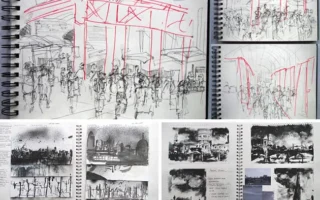Introduction:
In the contemporary landscape of design, the boundaries between disciplines blur, and synergies emerge to create cohesive and impactful environments. Graphic design, traditionally associated with print media and digital platforms, has found an expanding role within the realms of architecture and interior design. Its application transcends mere embellishment, serving as a fundamental tool for communication, expression, and user engagement. This exploration delves into the multifaceted ways in which graphic design is integrated into architecture and interior design, elucidating its transformative influence on spatial experiences and visual narratives.
1.Visual Identity and Branding: Shaping Architectural Narratives
Establishing Brand Identity: Architectural Signage and Logos
Environmental Graphics: Infusing Brand Identity into Built Environments
Cohesive Brand Experience: Consistency Across Architectural Elements
2.Wayfinding Systems: Navigating Architectural Spaces
Enhancing User Experience: Clear and Intuitive Signage
Information Design: Mapping Complex Architectural Layouts
Accessibility Considerations: Universal Design Principles in Wayfinding
3.Concept Visualization: Bringing Designs to Life
Architectural Rendering: Conveying Design Intent with Photorealism
Interior Visualization: Immersive Experiences through 3D Renderings
Conceptual Illustration: Capturing Atmosphere and Ambiance
4.Materiality and Texture: Integrating Graphic Elements
Custom Wall Treatments: Bespoke Patterns and Murals
Textile Design: Fabricating Unique Upholstery and Drapery
Surface Graphics: Graphic Applications on Floors, Ceilings, and Walls
5.Information Graphics: Communicating Complexity
Infographics: Simplifying Technical Information for Stakeholders
Data Visualization: Conveying Statistical Insights in Architectural Settings
Educational Graphics: Engaging Users with Informative Displays
6.Digital Fabrication and Prototyping: Pushing Boundaries
3D Printing: Prototyping Architectural Models and Custom Fixtures
CNC Machining: Precision Crafting of Graphic Elements
Laser Cutting: Intricate Detailing for Architectural Features
7.Art Integration: Elevating Aesthetic Appeal
Site-Specific Art Installations: Fusing Graphic Design with Sculptural Form
Bespoke Artwork: Tailoring Artistic Statements to Architectural Contexts
Art Curation: Curating Collections that Harmonize with Design Themes
8.Multimedia Experiences: Immersive Environments
Projection Mapping: Transforming Architectural Surfaces into Dynamic Canvases
Interactive Displays: Engaging Users with Touch-Sensitive Interfaces
Audiovisual Integration: Syncing Sound and Light with Spatial Design
Conclusion:
In the ever-evolving landscape of design, graphic design emerges as a versatile medium, seamlessly integrating with architecture and interior design to enhance functionality, evoke emotion, and elevate aesthetics. From establishing brand identity to navigating complex spaces, from visualizing design concepts to fabricating bespoke elements, graphic design permeates every aspect of the built environment. As designers embrace its potential for innovation and creativity, the synergy between graphic design, architecture, and interior design continues to shape immersive and unforgettable spatial experiences, enriching the fabric of our built world.




